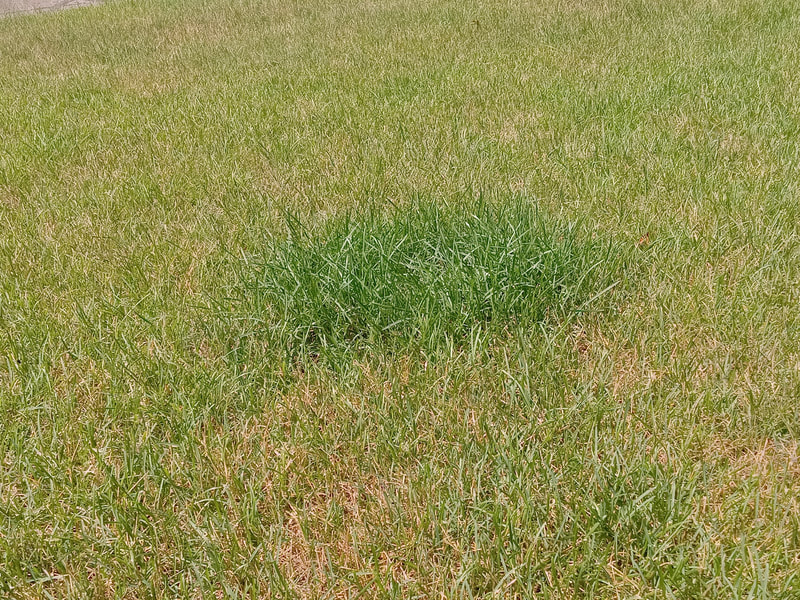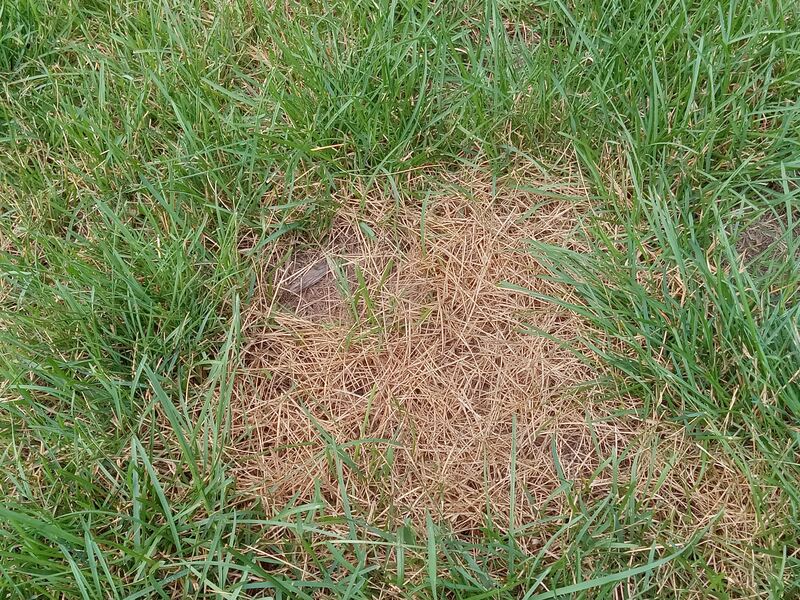Dogs love fertilizing lawns. They just don' t know when to quit. Here's what you can do to help.7/12/2022 Those of us with dogs know how hard it can be to keep the grass looking nice in the "potty area" of the yard. Female dogs especially are notoriously damaging to turf.
The question, though, is why? Female dogs, as well as some young males, senior males, and males who just never got the urge to lift their leg to pee, squat and deposit their urine directly into the turf. Males who lift their leg typically spread their pee around the yard, and actually pee on something like a tree or landscaping. So the yards where male dogs are peeing a little here and there typically don't see as much "urine burn" on the grass. But let's talk about the yards where dogs squat and pee right into the turf. A common misperception is that those urine burns come from the acidity in the dog's pee. And while urine is acidic, that's not actually what's causing the burn. It's actually nitrogen. Urine is pretty high in nitrogen, so what your dog is doing is fertilizing your grass whenever she pees. the problem is that she just doesn't know when enough is enough. With a female dog (or male dogs who squat to pee), there's a chance you've got some very lush-looking spots in your yard mixed in with some very dead-looking spots. The lush spots are where the dog's done some great work putting nitrogen into the soil. The dead spots are where she's overdone it. Either way, most of us don't want such uneven turf in our yard; we'd prefer a bit more uniformity. So what can you do about fixing this unevenness in the turf? First, don't waste your time and money on pills that claim to eliminate turf burn. They're just not effective. If anything, you could reduce the amount of protein in your dog's diet, as high-protein means higher nitrogen in the pee. That being said, there's still going to be nitrogen potentially burning your grass no matter how much you reduce the protein in her diet (and dogs do need protein, so you don't want to eliminate it altogether!). The more sustainable fix is to increase the frequency of your watering in the potty area. Normally, I suggest less-frequent but deeper waterings for your lawn, but when it comes to your dog's potty area, I suggest watering for 3-5 minutes every 1-2 days (you should also continue doing a deeper watering every 7 to 10 days). Even if you don't want to turn the sprinkler on for that short of a period, just put a spray nozzle on your hose and spray it down for a few minutes, giving a bit more attention to the specific spot where your dog recently peed. These frequent short waterings will help disperse the urine into the soil and dilute the nitrogen so you won't be facing so much unevenness or dead spots in your turf.
0 Comments
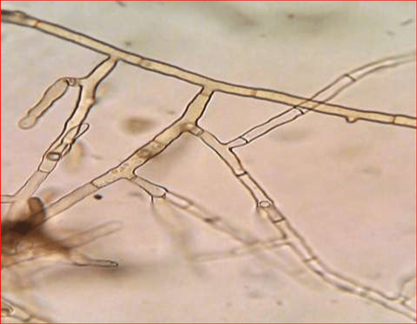 Rhizoctonia solani Rhizoctonia solani A recently-released study from an international group of scientists and researchers (link to PDF) shows that vermicompost (compost produced by worms) not only improves crop productivity, but actively fights fungal attacks that can destroy harvests. This is great news, not only for organic farmers, but also home gardeners who are looking to boost their harvest and prevent fungal outbreaks without using harmful synthetic fungicides and fertilizers. Their scientific conclusion: "The application of vermicomposting to agricultural land increases productivity by a multifaceted impact on soil health and crops, facilitating nutrient enrichment and preventing pathogen development. Vermicompost and its derivatives, such as vermiwash [liquid extract produced from earthworm-rich vermicompost], along with associated decomposer bacteria, act against fungal pathogens. The antifungal efficacy of vermicompost may be associated with bioactive compounds present in the CF [coelomic fluid], mucus, skin secretion of earthworms and metabolites secreted by decomposer bacteria. The CF of earthworms has an inherent ability to defend worms against diseases. It inhibits the growth of a variety of fungal pathogens, such as Rhizoctonia solani, Alternaria solani, Aspergillus niger, A. flavus, Fusarium oxysporum, and F. graminearum. The metabolites from vermicomposting bacteria, CF, mucus, and skin secretion synergistically combat phytopathogenic fungi. As an organic product, vermicompost and its derivatives are environmentally friendly. Thus, these products should be used to boost agricultural productivity by nutrient enrichment and reduction of plant fungal diseases." The layperson's summary: Worms which break down organic matter have to be able to fight off harmful bacterial and fungal pathogens in the soil, so they secrete fluids from their bodies to do this. These fluids are also present in the vermicompost (their poop) that we apply to the soil in our pots and gardens. Therefore the study shows that because of the composting worms' fluids present in the vermicompost, their vermicompost also acts as an antifungal agent for your plants. To order Living Worm Compost for your garden and potted plants, click here. Many gardeners use raised beds instead of planting in ground. There are several benefits to raised beds such as being able to control the quality of the soil, its easier on the back, and some feel it’s more aesthetically pleasing. For me I have hard clay soil and while we could amend it that would have taken several seasons to get it where I wanted it and I was too eager to get my garden going when we moved to this property.
Remember that a raised bed is basically a container, and should be filled with a potting mix, as you would a container. To fill raised beds I recommend the rule of thirds. Mix a third of the following ingredients:
If your beds are tall you can fill the very bottoms with leaves, sticks, and cardboard to save money. You can reserve the top half of the beds for the compost and coconut coir as a money saving measure. Coconut Coir is something that's popped up in more and more organic gardening conversations in recent years. It's also a popular growing medium for hydroponic gardening. But what is it, and how can it help your garden grow? The folks at Epic Gardening have a fantastic write-up on coconut coir, from its origins to all of the great benefits of using it. First, we need to understand what coconut coir actually is. 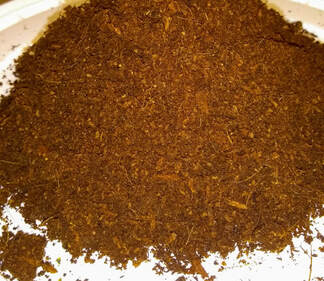 So when it comes to adding coco coir to your garden soil, how much should you use? For starting pots and raised beds, we'd recommend a 1/3 - 1/3 - 1/3 mix of screened topsoil, compost and coco coir. Basically, equal parts of soil, compost (either vermicompost or traditional compost) and coir. This will give your soil a great foundation for holding moisture as well as nutrients, while remaining light enough for air and roots to move freely. 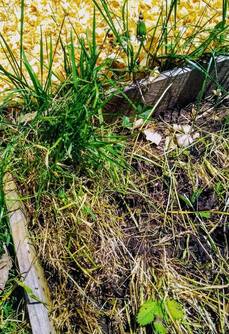 You ever notice grass growing in your garden? Or in a flower bed? It can be downright tenacious. It grows, it spreads, and left unchecked for a few weeks, it can just overwhelm the area. Grass is essentially an aggressive weed when it grows in the wrong place. Do you know why grass aggressively infiltrates your garden and flower space? It's because most of us work really hard to give our tomatoes and peppers and marigolds and petunias and basil plants healthy soil. It's that healthy soil that draws the grass in. So now let me ask you: Does it grow tenaciously in your lawn? Or is it thinner than you'd like? Are there bare spots? Are there spots in your lawn where other things have taken over and the grass is just non-existent? If so, you're not alone. The problem is that we focus on creating healthy soil for our garden beds and flower beds (with mulch and compost and other soil amendments), but then just don't think about the soil under our grass. And then we wonder why grass grows tenaciously in our gardens, which has soil chock full of organic matter, but there are bald and weak spots all over our lawn. Getting healthy soil under your lawn isn't something that you can fix by dumping on synthetic chemicals (like Scotts). To get that nice healthy tenacious grass, you need to put as much attention into getting organic matter into your lawn's soil as you do with your garden's soil. How do you do that? With organic fertilizer and topdressing. Getting more organic matter into your soil is critically important for your turf. Our fertilization service includes an Alfalfa Blend Fertilizer to do just that (a blend of alfalfa meal, spent distillers grains & kelp). But you can also DIY by topdressing with compost, or fertilizing with something like alfalfa pellets (40 pounds per 1000 square feet of turf), or Purely Organic Lawn Food (25 pounds per 5000 square feet of turf) or our own Alfalfa Blend Lawn Fertilizer (35 pounds per 5000 square feet). Topdressing and/or fertilizing should be done twice a year, in spring (April/May) and late summer (late August to mid September). You want to build up the soil and get those nutrients down just before the grass's growing season starts, which in Michigan is spring and fall. If you've got questions about adding organic matter to your lawn, or are interested in learning more about our organic lawn fertilization, shoot me an email at [email protected] |

